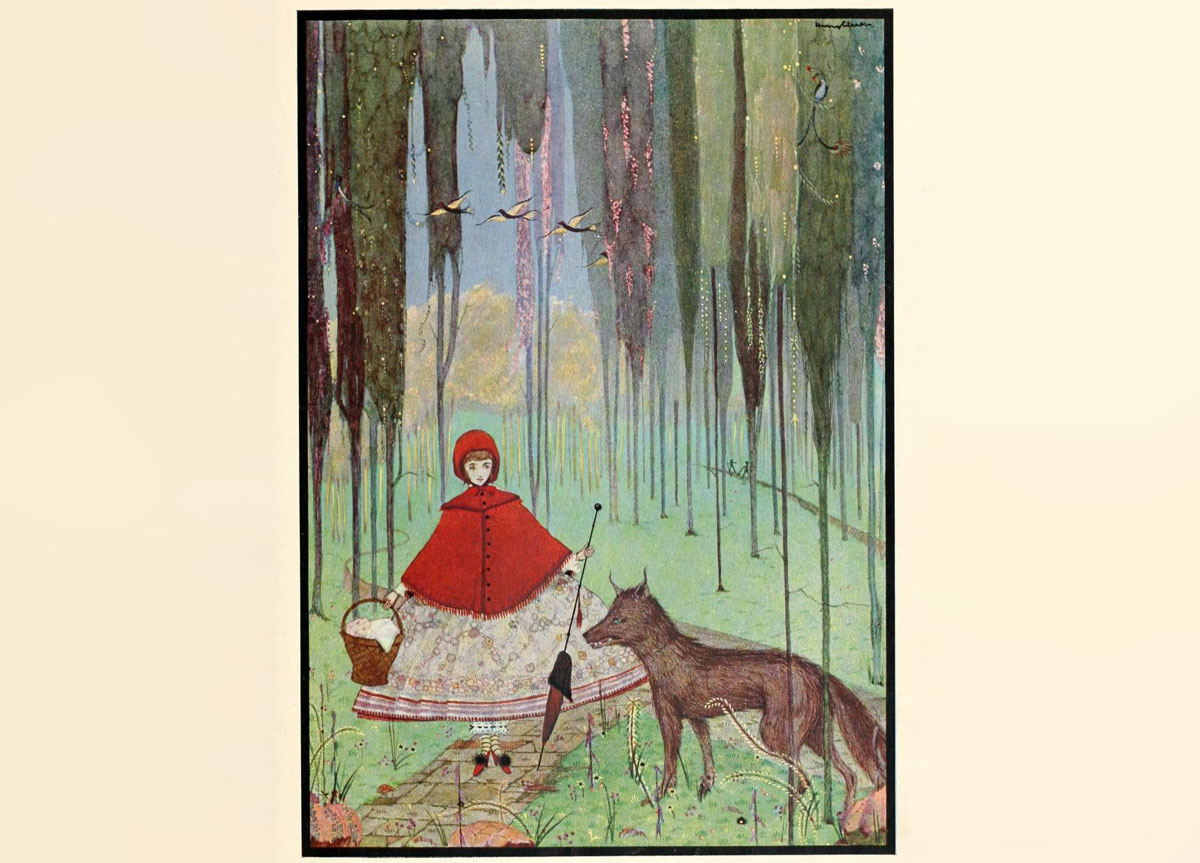Author: Charles Perrault
Original dates and places of publication: 1697, Paris; 1729, London (first English translation)
Original publishers: Privately printed Literary form: Children’s story
* * *
Once upon a time, there lived in a certain village, a little country girl, the prettiest creature was ever seen. Her mother was excessively fond of her; and her grand-mother doated on her much more. This good woman got made for her a little red riding-hood ; which became the girl so extremely well, that every body called her Little Red Riding-Hood.
One day, her mother, having made some girdle-cakes, said to her:
“Go, my dear, and see how thy grand-mamma does, for I hear she has been very ill, carry her a girdle-cake, and this little pot of butter.”
Little Red Riding-Hood set out immediately to go to her grand-mother, who lived in another village. As she was going thro’ the wood, she met with Gaffer Wolf, who had a very great mind to eat her up, but he durst not, because of some faggot-makers hard by in the forest.
He asked her whither she was going. The poor child, who did not know that it was dangerous to stay and hear a Wolf talk, said to him:
“I am going to see my grand-mamma, and carry her a girdle-cake, and a little pot of butter, from my mamma.”
“Does she live far off?” said the Wolf.
“Oh! ay,” answered Little Red Riding-Hood, “it is beyond that mill you see there, at the first house in the village.”
“Well,” said the Wolf, “ and I’ll go and see her too : I’ll go this way, and you go that, and we shall see who will be there soonest.”
The Wolf began to run as fast as he could, taking the nearest way; and the little girl went by that farthest about, diverting herself in gathering nuts, running after butterflies, and making nosegays of such little flowers as she met with. The Wolf was not long before he got to the old woman’s house : he knocked at the door, tap, tap.
“Who’s there?”
“Your grand-child, Little Red Riding-Hood,” replied the Wolf, counterfeiting her voice, “ who has brought you a girdle-cake, and a little pot of butter, sent you by mamma.”
The good grand-mother, who was in bed, because she found herself somewhat ill, cry’d out:
“Pull the peg, and the bolt will fall.”
The Wolf pull’d the peg, and the door opened, and then presently he fell upon the good woman, and ate her up in a moment; for it was above three days that he had not touched a bit. He then shut the door, and went into the grandmother’s bed, expecting Little Red Riding-Hood, who came some time afterwards, and knock’d at the door, tap, tap.
“Who’s there?”
Little Red Riding-Hood, hearing the big voice of the Wolf, was at first afraid; but believing her grand-mother had got a cold, and was hoarse, answered:
“ ’Tis your grand-child, Little Red Riding-Hood, who has brought you a girdle-cake, and a little pot of butter, mamma sends you.”
The Wolf cried out to her, softening his voice as much as he could, “Pull the peg, and the bolt will fall.”
Little Red Riding-Hood pulled the peg, and the door opened. The Wolf seeing her come in, said to her, hiding himself under the bedclothes:
“Put the cake, and the little pot of butter upon the bread-bin, and come and lye down with me.”
Little Red Riding-Hood undressed herself, and went into bed; where, being greatly amazed to see how her grandmother looked in her night-cloaths, she said to her:
“Grand-mamma, what great arms you have got! ”
“That is the better to hug thee, my dear.”
“Grand-mamma, what great legs you have got! ”
“That is to run the better, my child.”
“Grand-mamma, what great ears you have got! ”
“That is to hear the better, my child.”
“Grand-mamma, what great eyes you have got!”
“It is to see the better, my child.”
“Grand-mamma, what great teeth you have got!”
“That is to eat thee up.”
And, saying these words, this wicked Wolf fell upon poor Little Red Riding-Hood, and ate her all up.
* * *
THE MORAL
From this short story easy we discern
What conduct all young people ought to learn.
But above all, young, growing misses fair,
Whose orient rosy blooms begin t’appear:
Who, beauties in the fragrant spring of age,
With pretty airs young hearts are apt t’engage.
Ill do they listen to all sorts of tongues,
Since some inchant and lure like Syrens’ songs.
No wonder therefore ’tis, if over-power’d,
So many of them has the Wolf devour’d.
The Wolf, I say, for Wolves too sure there are
Of every sort, and every character.
Some of them mild and gentle-humour’d be,
Of noise and gall, and rancour wholly free;
Who tame, familiar, full of complaisance
Ogle and leer, languish, cajole and glance;
With luring tongues, and language wond’rous sweet,
Follow young ladies as they walk the street,
Ev’n to their very houses, nay, bedside,
And, artful, tho’ their true designs they hide;
Yet ah! these simpering Wolves! Who does not see
Most dangerous of Wolves indeed they be?
* * *
SUMMARY
Little Red Riding Hood was part of the collection “Histoires ou Contes du temps passe, avec des Moralites, stories created out of folktales by Charles Perrault, that was intended to be used in the nurseries at Versailles in the court of Louis XIV. Perrault’s tales were first translated into English in 1729 by Robert Samber in Histories or Tales of Past Times. The story, now often published alone, has undergone numerous transformations. The popular contemporary version found in children’s books in the United States is based upon the rewriting of the folktale by Jacob and Wilhelm Grimm that appeared as “Little Red Cap” in their Nursery and Household Tales, published in Germany in 1812. The first accurate U.S. translation of this collection appeared in 1944 as Grimm’s Fairy Tales.
Little Red Riding Hood is the story of a sweet young girl who visits her grandmother and takes with her a basket of food and wine. As she travels through the woods on her way to her grandmother’s house, she meets a wolf who asks where she is going. After she tells him, the wolf takes a shortcut and arrives at grandmother’s house long before Little Red Riding Hood. He eats grandmother, dresses in her clothing, and waits for the little girl to arrive. Puzzled by her grandmother’s appearance, the little girl states a series of observations regarding the large size of the wolfs eyes, ears, and other parts. The final observation is “Oh, Grandmother, what a terribly big mouth you have.” The wolf responds by leaping forward and shouting “The better to eat you with, my dear.” He then eats Little Red Riding Hood. After the wolf falls asleep, a hunter appears, cuts open the wolfs stomach, and frees the little girl and her grandmother. They gather large rocks and place them in the wolfs stomach. Then the hunter joins them in celebrating by eating the food and drinking the wine.
CENSORSHIP HISTORY
Perrault’s Little Red Riding Hood ended with both the little girl and her grandmother dead and no hunter to save them. The fairytales were written for the court of Louis XIV as a means of teaching children about the dangers lurking in the world surrounding them. Perrault’s moral is not stated, but his tale may have been intended as a warning against strangers and traveling alone. Contemporary writers, such as Maria Tatar and Jack Zipes, suggest that a specific warning appears to be directed toward women, reminding them of their need for male protectors.
The Grimm brothers softened the ending to suit their intention of entertainment rather than the moralizing of Perrault’s tales. They included a fierce woodsman with an axe to rescue and resuscitate the two female characters and retained the violent appearance and behavior of the wolf. Versions published in the United States have maintained the ending, but they have varied in regard to the violence contained within the story, sometimes making the woodsman into a kind hunter who saves Little Red Riding Hood and her grandmother.
Challenges to the story in the United States have involved the 1989 version published by Houghton Mifflin that won the Caldecott Honor Book Award. In 1990, the Empire, California, school district banned the book from the district because the bottle of wine appeared to “condone the use of alcohol” to district decision makers. The district curriculum director expressed further concern that the descriptions of the hunter’s rescue of Little Red Riding Hood and her grandmother were too violent and inappropriate for young students. That same year, the book was also banned from elementary schools in Culver City, California, because the story “gives the wrong impression about alcohol” to children. Assistant Superintendent Vera Jashni expressed specific concern about the final paragraph of the story, which tells that, after the hunter has killed the wolf, the grandmother drinks some of the wine. She then feels strong and healthy enough to clean up that mess left by the wolf.
The presence of the wine bottle in illustrations of Little Red Riding Hood motivated challenges by parents of students in the fifth and sixth grades in the Clay County, Florida, elementary schools in 1990. The school board established a review committee to consider the objections and to examine the books, and the books were removed from the classrooms during the three weeks that the committee deliberated. The books were later returned to the classrooms after the review committee voted to retain the books and the school board concurred with their decision.
In 1991, a teacher in Bradford County, Florida, initiated a complaint that the book was violent because of the actions of the wolf. The teacher also questioned the appropriateness of the little girl taking wine to her grandmother and her grandmother later drinking the wine. The book was placed on the “restricted” shelf, where it was available only to students who specifically requested the book by tide and author, while the school sought to locate a “nonalcoholic” version. In the same year, two teachers in Levy County, Florida, challenged the storybook for the same reason, but a review committee of educators and parents voted to retain the book in the schools.
FURTHER READING
Bettelheim, Bruno. The Uses of Enchantment: The Meaning and Importance of Fairy Tales. New York: Random House, 1977.
Chase, Richard, Jr. “Little Red Riding Hood: Werewolf and Prostitute.” Journal of History 57 (Summer 1995): 769-776.
Moore, Robert B. “From Rags to Witches: Stereotypes, Distortions and Anti-Humanism in Fairy Tales.” CIBC Bulletin 8 (1975): 1.
Newsletter on Intellectual Freedom (July 1990): 128.
Tatar, Maria. The Hard Facts of the Grimm’s Fairy Tales. Princeton, N.J.: Princeton University Press, 1987.
Zipes, Jack. Fairy Tales and the Art of Subversion: The Classical Genre for Children and the Process of Civilization. New York: Wildman Press, 1983.





